hotrod jigs
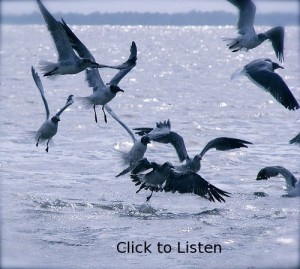 Radios blaring, airplanes buzzing, stereos thumping, outboards droning, helicopters whirring, sirens wailing – Wow! I spent a lot of my time on the water this weekend just listening. Boat shows, trolling tournaments, and sailing regattas made the main stem of the Chesapeake very noisy. The Bay is fully awake from her winter slumber and the crowds are back in force. While we each enjoy the water in our preferred ways, to my thinking fishing should include elements of solitude and stealth. I don’t know about you, but I’d rather pick up aluminum cans at rush hour along I-95 than try to pick off rockfish in the main channel on a busy weekend. I prefer to look off the beaten path for places where I can tune-in to something a little more pleasing than the clamorous dissonance of the masses. At this busy time of the year, I want to listen for the sounds of laughter.
Radios blaring, airplanes buzzing, stereos thumping, outboards droning, helicopters whirring, sirens wailing – Wow! I spent a lot of my time on the water this weekend just listening. Boat shows, trolling tournaments, and sailing regattas made the main stem of the Chesapeake very noisy. The Bay is fully awake from her winter slumber and the crowds are back in force. While we each enjoy the water in our preferred ways, to my thinking fishing should include elements of solitude and stealth. I don’t know about you, but I’d rather pick up aluminum cans at rush hour along I-95 than try to pick off rockfish in the main channel on a busy weekend. I prefer to look off the beaten path for places where I can tune-in to something a little more pleasing than the clamorous dissonance of the masses. At this busy time of the year, I want to listen for the sounds of laughter.
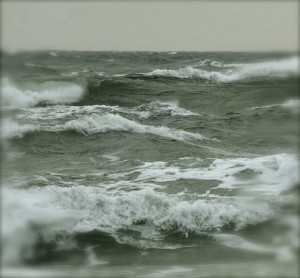 At least they must have been precious in his sight last weekend when an epic spring storm kept many fishermen off the Bay on the opening day of Maryland’s striped bass catch-and-kill season. Water temperatures are lower than usual this April, so there are lots of pre-spawn fish still moving up the Bay. I’d guess at least a couple of thousand more roe-laden cows made it to the spawning grounds this weekend that otherwise wouldn’t have, but for the storms. Let’s hope that translates into millions of additional baby rockfish. Even though I usually root for the fish, I still get excited about opening weekend because the recreational rockfish season in Maryland is definitely worth celebrating. With all the commercial poaching we saw this winter, it’s amazing to me that there are any fish left to catch. Since there are still a few around, let’s thank the Lord for that too!
At least they must have been precious in his sight last weekend when an epic spring storm kept many fishermen off the Bay on the opening day of Maryland’s striped bass catch-and-kill season. Water temperatures are lower than usual this April, so there are lots of pre-spawn fish still moving up the Bay. I’d guess at least a couple of thousand more roe-laden cows made it to the spawning grounds this weekend that otherwise wouldn’t have, but for the storms. Let’s hope that translates into millions of additional baby rockfish. Even though I usually root for the fish, I still get excited about opening weekend because the recreational rockfish season in Maryland is definitely worth celebrating. With all the commercial poaching we saw this winter, it’s amazing to me that there are any fish left to catch. Since there are still a few around, let’s thank the Lord for that too!
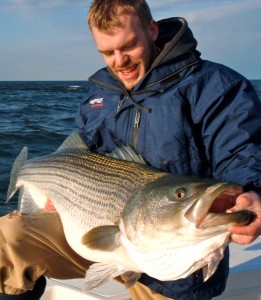 No, it’s not the opening weekend of striped bass catch-and-kill season in Maryland’s Chesapeake Bay. That doesn’t happen until April, 16th. The opening I’m speaking of is the first day of baseball season. The Baltimore Orioles played their home opener today. Since they’re undefeated so far this season, there’s been plenty of celebrating. The Washington Nationals started their season last Thursday. They opened against the Atlanta Braves this year. I’m originally from the southeast so I’ve always followed the Braves. I’ve recently become a fan of their division rivals the Nationals because they have such a beautiful stadium so close to home. I looked forward to watching these two teams play this year. My son Cory is a rabid Braves fan so he took some time off to travel up from Tennessee to root against me. His long weekend got off to a good start when the Braves dropped the Nats 2-0. It got even better on Friday when he caught the biggest rockfish of his life, then broke his record twice on his next two casts! Read More!
No, it’s not the opening weekend of striped bass catch-and-kill season in Maryland’s Chesapeake Bay. That doesn’t happen until April, 16th. The opening I’m speaking of is the first day of baseball season. The Baltimore Orioles played their home opener today. Since they’re undefeated so far this season, there’s been plenty of celebrating. The Washington Nationals started their season last Thursday. They opened against the Atlanta Braves this year. I’m originally from the southeast so I’ve always followed the Braves. I’ve recently become a fan of their division rivals the Nationals because they have such a beautiful stadium so close to home. I looked forward to watching these two teams play this year. My son Cory is a rabid Braves fan so he took some time off to travel up from Tennessee to root against me. His long weekend got off to a good start when the Braves dropped the Nats 2-0. It got even better on Friday when he caught the biggest rockfish of his life, then broke his record twice on his next two casts! Read More!
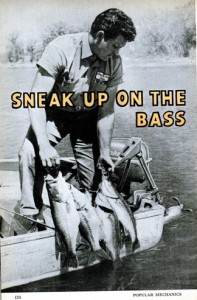 “Show me a fisherman and I’ll show you a scoundrel and a sneak,” says well-known outdoor writer Bob Lawless. I don’t hang out with too many scoundrels, but every good fisherman I know is a sneak. In an article about newly-invented trolling motors, the April 1960 edition of Popular Mechanics offers this observation: “Big fish don’t get to be bigger fish by being dumb. They get big by learning to recognize predators in their midst.” Stealth is one of fishing’s primary skills.
“Show me a fisherman and I’ll show you a scoundrel and a sneak,” says well-known outdoor writer Bob Lawless. I don’t hang out with too many scoundrels, but every good fisherman I know is a sneak. In an article about newly-invented trolling motors, the April 1960 edition of Popular Mechanics offers this observation: “Big fish don’t get to be bigger fish by being dumb. They get big by learning to recognize predators in their midst.” Stealth is one of fishing’s primary skills.
By swimming and scuba diving I’ve learned that some sounds are easily transferred through the water. Surface conversations can be heard down to about fifteen feet while the thump of loud music or an object falling onto the deck of a boat can be detected even deeper. The most recognizable underwater noise is made by running outboards and whirling props.
Some fishermen are so careful about noise that they won’t even turn on their sonar units when they know they’re over fish. It’s been proven that fish can detect the pings. I’m not always that sneaky, but I’ve learned a little something over the years about how important stealth can be. Take a look at the monster light tackle stripers in this report and you’ll see what I mean!
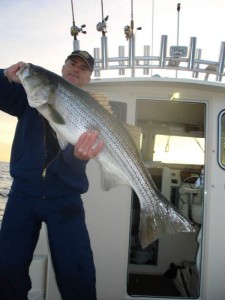 Maybe I’m getting better, but more likely I just got lucky. Either way, I called this last pattern change pretty close. As the water cools, big fish move closer to the main channel of the Chesapeake Bay. There’s still plenty of smaller fish in the rivers and the nearby flats, but since it’s late November and the season for trophies, it’s time to lock in on the channel. Here are two good reasons: Number one – water temperature. Striped bass prefer water that is warmer than 50 degrees. Surface temperatures right now in most of the Maryland section of the Chesapeake Bay are in the low 50s. Since the deeper water near the channel can be ten degrees warmer than it is in the rivers, stripers will stay closer to their comfort zone. You’ll see them holding very close to the bottom on the fish finder. They will still move up shallow to eat, but they’ll go right back to the deeper water to rest between feeding frenzies.
Maybe I’m getting better, but more likely I just got lucky. Either way, I called this last pattern change pretty close. As the water cools, big fish move closer to the main channel of the Chesapeake Bay. There’s still plenty of smaller fish in the rivers and the nearby flats, but since it’s late November and the season for trophies, it’s time to lock in on the channel. Here are two good reasons: Number one – water temperature. Striped bass prefer water that is warmer than 50 degrees. Surface temperatures right now in most of the Maryland section of the Chesapeake Bay are in the low 50s. Since the deeper water near the channel can be ten degrees warmer than it is in the rivers, stripers will stay closer to their comfort zone. You’ll see them holding very close to the bottom on the fish finder. They will still move up shallow to eat, but they’ll go right back to the deeper water to rest between feeding frenzies.
The second reason to fish near the channel is bait. Larger fish want bigger bait. The most common baitfish of any consequence in the Bay right now is menhaden. Since they migrate toward warmer water just like rockfish, by late November they are well on their way toward their comfort zones farther south. That means there is less and less bait in the upper reaches of the Bay and the biggest concentrations of menhaden are now near the channel. That’s perfect conditions for big stripers because they can hang out in the deeper warmer water and still ambush big bait. That doesn’t mean they’ll bite anything you throw at them though. Well, maybe the smaller fish will, but there’s a secret to getting the trophies. Read More!
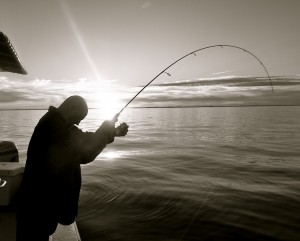 Whenever someone asks me how I feel about making striped bass a gamefish in Maryland, my answer is always the same – they already are. Light tackle anglers fish for striped bass almost the same as we would for black bass, trout, crappie, or walleye. Most of us use the same equipment. The only real difference I can see is that a few influential people in the mid-Atlantic find it profitable to commercially harvest stripers. I never heard of striped bass on a restaurant menu until I moved to Maryland. In fact, people in other parts of the country don’t consider them particularly good to eat. I cook them occasionally, but is any fish tasty enough to deserve all the controversy that surrounds striped bass? The biggest thing they have going for them is that they’re fun to catch and they’re pursued by more recreational anglers than any other species. In my book, that spells gamefish. Last week the Atlantic States Marine Fisheries Commission (ASMFC) voted down several amendments which would have increased the commercial harvest of striped bass. Maryland voted for no increase. That’s a positive sign from a state that traditionally harvests and sells more than its fair share, but it’s no reason to celebrate. Maintaining the status quo is just more bad news for the fish. Read More!
Whenever someone asks me how I feel about making striped bass a gamefish in Maryland, my answer is always the same – they already are. Light tackle anglers fish for striped bass almost the same as we would for black bass, trout, crappie, or walleye. Most of us use the same equipment. The only real difference I can see is that a few influential people in the mid-Atlantic find it profitable to commercially harvest stripers. I never heard of striped bass on a restaurant menu until I moved to Maryland. In fact, people in other parts of the country don’t consider them particularly good to eat. I cook them occasionally, but is any fish tasty enough to deserve all the controversy that surrounds striped bass? The biggest thing they have going for them is that they’re fun to catch and they’re pursued by more recreational anglers than any other species. In my book, that spells gamefish. Last week the Atlantic States Marine Fisheries Commission (ASMFC) voted down several amendments which would have increased the commercial harvest of striped bass. Maryland voted for no increase. That’s a positive sign from a state that traditionally harvests and sells more than its fair share, but it’s no reason to celebrate. Maintaining the status quo is just more bad news for the fish. Read More!


